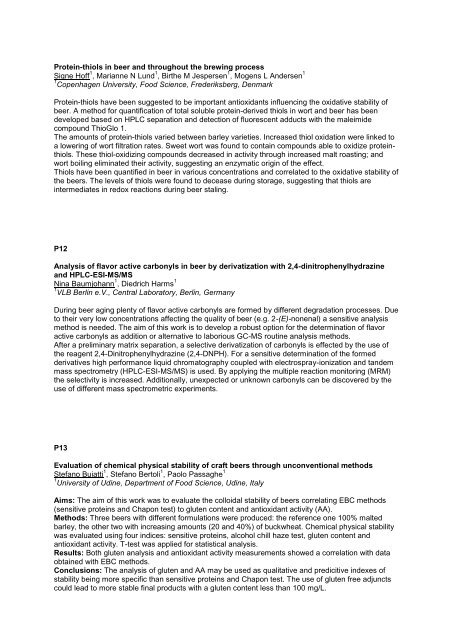here - the 34th European Brewery Convention
here - the 34th European Brewery Convention
here - the 34th European Brewery Convention
Create successful ePaper yourself
Turn your PDF publications into a flip-book with our unique Google optimized e-Paper software.
Protein-thiols in beer and throughout <strong>the</strong> brewing process<br />
Signe Hoff 1 , Marianne N Lund 1 , Bir<strong>the</strong> M Jespersen 1 , Mogens L Andersen 1<br />
1 Copenhagen University, Food Science, Frederiksberg, Denmark<br />
Protein-thiols have been suggested to be important antioxidants influencing <strong>the</strong> oxidative stability of<br />
beer. A method for quantification of total soluble protein-derived thiols in wort and beer has been<br />
developed based on HPLC separation and detection of fluorescent adducts with <strong>the</strong> maleimide<br />
compound ThioGlo 1.<br />
The amounts of protein-thiols varied between barley varieties. Increased thiol oxidation were linked to<br />
a lowering of wort filtration rates. Sweet wort was found to contain compounds able to oxidize proteinthiols.<br />
These thiol-oxidizing compounds decreased in activity through increased malt roasting; and<br />
wort boiling eliminated <strong>the</strong>ir activity, suggesting an enzymatic origin of <strong>the</strong> effect.<br />
Thiols have been quantified in beer in various concentrations and correlated to <strong>the</strong> oxidative stability of<br />
<strong>the</strong> beers. The levels of thiols were found to decease during storage, suggesting that thiols are<br />
intermediates in redox reactions during beer staling.<br />
P12<br />
Analysis of flavor active carbonyls in beer by derivatization with 2,4-dinitrophenylhydrazine<br />
and HPLC-ESI-MS/MS<br />
Nina Baumjohann 1 , Diedrich Harms 1<br />
1 VLB Berlin e.V., Central Laboratory, Berlin, Germany<br />
During beer aging plenty of flavor active carbonyls are formed by different degradation processes. Due<br />
to <strong>the</strong>ir very low concentrations affecting <strong>the</strong> quality of beer (e.g. 2-(E)-nonenal) a sensitive analysis<br />
method is needed. The aim of this work is to develop a robust option for <strong>the</strong> determination of flavor<br />
active carbonyls as addition or alternative to laborious GC-MS routine analysis methods.<br />
After a preliminary matrix separation, a selective derivatization of carbonyls is effected by <strong>the</strong> use of<br />
<strong>the</strong> reagent 2,4-Dinitrophenylhydrazine (2,4-DNPH). For a sensitive determination of <strong>the</strong> formed<br />
derivatives high performance liquid chromatography coupled with electrospray-ionization and tandem<br />
mass spectrometry (HPLC-ESI-MS/MS) is used. By applying <strong>the</strong> multiple reaction monitoring (MRM)<br />
<strong>the</strong> selectivity is increased. Additionally, unexpected or unknown carbonyls can be discovered by <strong>the</strong><br />
use of different mass spectrometric experiments.<br />
P13<br />
Evaluation of chemical physical stability of craft beers through unconventional methods<br />
Stefano Buiatti 1 , Stefano Bertoli 1 , Paolo Passaghe 1<br />
1 University of Udine, Department of Food Science, Udine, Italy<br />
Aims: The aim of this work was to evaluate <strong>the</strong> colloidal stability of beers correlating EBC methods<br />
(sensitive proteins and Chapon test) to gluten content and antioxidant activity (AA).<br />
Methods: Three beers with different formulations were produced: <strong>the</strong> reference one 100% malted<br />
barley, <strong>the</strong> o<strong>the</strong>r two with increasing amounts (20 and 40%) of buckwheat. Chemical physical stability<br />
was evaluated using four indices: sensitive proteins, alcohol chill haze test, gluten content and<br />
antioxidant activity. T-test was applied for statistical analysis.<br />
Results: Both gluten analysis and antioxidant activity measurements showed a correlation with data<br />
obtained with EBC methods.<br />
Conclusions: The analysis of gluten and AA may be used as qualitative and predicitive indexes of<br />
stability being more specific than sensitive proteins and Chapon test. The use of gluten free adjuncts<br />
could lead to more stable final products with a gluten content less than 100 mg/L.





